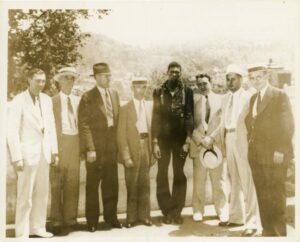
Story behind the accused murderer in 1936 Battery Park Hotel homicide
Back at the courthouse, Martin was taken into a room with several of the investigators. He was grilled for hours. He stuck to his story. The gun was his, but it was not in his possession the night of the murder. One of the officers — the sheriff’s brother — left the room and returned with a short length of rubber hose that he had taken from the nearby janitor’s closet.
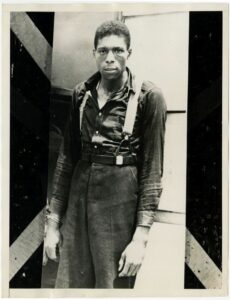
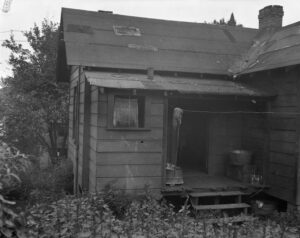
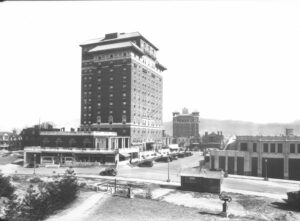
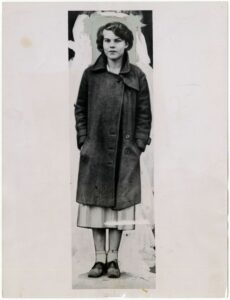
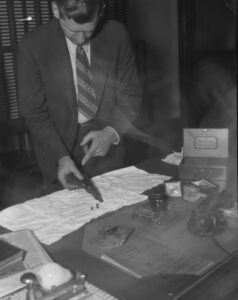
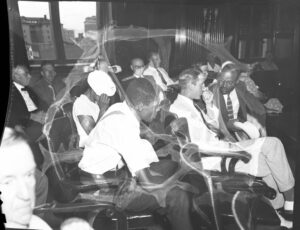
“I don’t know whether my brother Tom will get here tomorrow for my body or not. Tonight’s his night off,” 22-year-old Martin Moore, a tall and lanky Black man, mumbled to the cadre of reporters stationed outside the bars of his cell in Raleigh’s Central Prison. It was Dec. 10, 1936, and without a pardon from the governor, Martin would enter the gas chamber at 10:30 the following morning.
It had been less than five months since Martin had been convicted of murder — though his original execution date had been set for only six weeks from when the guilty verdict was read.
Prior to his arrest, Martin lived in a small house on Hill Street in Asheville with his mother, Celia, and sister, Alice. The trio had moved to Asheville from Spartanburg, South Carolina, when Martin was in grade school.
Celia worked laundering clothes. Alice cooked and cleaned for a white family. Martin attended nearby Hill Street School through the sixth grade, but quit in order to help support his family. Martin, like many people who lived in his historically Black neighborhood, eventually found work at the Battery Park Hotel, one of the many luxury hotels serving downtown Asheville’s tourism industry. Hotel work was good, steady work for the Black population in segregated 1930s Asheville. And the Battery Park Hotel was within short walking distance of Martin’s Hill Street home.
By all accounts, Martin was an exemplary employee. He worked at the Battery Park as a full-time hallboy, or janitor, for nearly three years with no complaints. He was thorough, dedicated, and punctual — despite a split shift schedule that consisted of short early morning shifts followed by a longer day shift and then another short night shift.
The hotel’s manager, Pat Branch, said of Martin during his trial, “I would say that any employee that has worked in your hotel, and you have been associated with him and seen him working for two and one-half years, and he has never given you any trouble, and you have never heard anything against him, ought to be a pretty good man.”
But, yet, in the early morning hours of Aug. 9, 1936, nearly three weeks after the sensational slaying of a 19-year-old white New York University student, Helen Clevenger, in her room at the Battery Park Hotel, Martin Moore signed a statement confessing to her murder, which read in part:
“When I entered the room [Helen] said, ‘What do you want?’ I told her I opened the door, I did not know she was in there. I looked at her and she said, ‘I am going to scream.’ I told her not to. So she screamed once. I closed the door. She said, ‘You better get out of here or I’ll call the office.’ I was standing close to her and I shot her before she could go back and I hit her with the butt [of the gun]. She fell on her knees, she screamed again and I hit her again, she screamed again and I hit her twice.”
Just a week after signing the confession, an officer escorted Martin, handcuffed, to the defense table inside the Superior Courtroom at the Buncombe County Courthouse. His trial began.
Helen had been killed around 1 a.m. on July 16, 1936. July 15 had been a relatively normal day for Martin. He completed his shifts at the hotel and then walked to Fannie Lee Gilliam’s house to attend her birthday party. He and Fannie had been dating for almost a year.
He remembered the night in detail, recalling that he arrived at Fannie’s around 8:30 p.m. and socialized with her and a couple other people in her kitchen until about 9:45 p.m. He was tired and decided to call it an early night, but Fannie wanted him to stay longer.
“I started to leave,” Martin said, “and Fannie Lee [came] as far as the yard with me, so me and her stood and talked five or ten minutes, until Gene Williams and his wife, Virgie, came along. [Fannie] said ‘Come and go back to the house.’ I went to the kitchen for ten or fifteen minutes. I told her I was feeling bad, and I believed I would go home. She said, ‘You can lay down across my [bed].’ I went and laid down on the bed. When I woke up her clock was five minutes to two. I got up and went home.” Gene and Virgie confirmed Martin’s alibi.
Martin slept until 4 a.m., then walked to the hotel for his early morning, 45-minute cleaning shift. He returned home again and slept until his mother woke him at 7:15 a.m. He was back at the hotel before his regular 8 a.m. day shift began. He entered through the employee entrance at the back of the hotel — Black people were not allowed to use the front doors — and stashed his belongings in his locker in the basement-level locker room.
Martin was cleaning the first floor when, around 8:30 a.m., Helen’s uncle opened his niece’s unlocked hotel room door on the second floor. Her bloodied body lay crumpled on the floor. She had been shot through the chest and beaten in the face.
On the first floor, guests checked out of the hotel, bellhops carried luggage, and waitresses served breakfast — all unaware of the drama that was unfolding above. The hotel manager did his best to keep it that way. Helen’s room was sealed, her uncle was secured in his own room, the coroner was called, and the few staff members who had been alerted to the suspicious death quietly waited. It was not until 9:30 a.m. that manager Pat Branch called the sheriff’s office.
Martin first heard about the murder from a co-worker as they cleaned a back stairway. He could not recall having noticed Helen in the hotel.
Martin’s shift ended at noon and he headed home. By that time, officers from the Sheriff’s Department had begun their investigation into Helen’s death in earnest, sealing the second floor and questioning the few eyewitnesses they could find, but Martin had not yet learned much about what had occurred the night before.
Martin was due back at work at 8 p.m. During his break, he walked over to another Hill Street house, which belonged to the grandmother of his friend and co-worker, Lem Roddy. Lem pulled him aside and handed him a .32 Spanish automatic pistol that he had borrowed from Martin a couple days earlier. It had a “stain” on it.
Martin, scared, stuffed it in his pants and returned home. He crawled underneath his mother’s house and hid the gun on a rafter.
For the next few weeks, Martin went to work as usual. He and the other employees were questioned by officers, but since Martin had not been on duty at the time of the murder and no one had seen him at the hotel after the end of his shift, his interview was brief.
Investigators were instead focusing their efforts on stocky, white men who could have been in the hotel that evening. Shortly after 1 a.m. on July 16, several witnesses had seen a man fitting that description sneaking through the hotel lobby, bursting through a door in the manager’s office, and vaulting the hotel’s balcony to the street below. They were holding three white men in the jail, including Helen’s uncle, but had not charged any of them with a crime.
After more than three weeks without an arrest, the sheriff’s office, and particularly the lead investigator, Buncombe County Sheriff Laurence Brown, who was up for reelection in a few months, were getting desperate. The public was clamoring for answers.
Then the stalled investigation shifted. One eyewitness, who had spoken to a “shadowy figure” in Helen’s doorway the night of her murder, had changed his story at the urging of the sheriff. He had previously insisted that the figure had been a white man, but now he was certain that it had been a Black man. The investigators called Martin and the other Black employees back in for questioning. They asked Martin if he owned a gun. He told them he did not. They released him.
Back at work, Martin mopped alongside his co-worker, Banks Taylor.
“Do you know that girl was shot with an automatic just like yours?” Banks told Martin. “I sure am glad I gave mine to my old man.”
Martin looked up at Banks. “Yeah, it don’t worry me none ‘cause I lent mine to Lem Roddy two days before the girl got killed.
The next day, Banks and Lem were brought to the sheriff’s office. After an extensive “grilling” by officers and an inspection and elimination of Banks’ gun as the murder weapon, Banks told the officers, “What you worryin’ me so much for? Martin Moore got a gun. Why don’t you worry him?”
Less than an hour later, just after midnight on Aug. 9, officers burst into Martin Moore’s small bedroom, woke him, and began bombarding him with questions.
“Give me that gun you killed that girl with!” one of the investigators shouted above the din of the other officers pushing their way toward the young man.
“I ain’t got no gun,” Martin, now fully awake, told the men towering over his bed.
“Tell them where the gun is,” Banks Taylor, who had accompanied law enforcement, interjected.
“All right, I own a gun, but I lent it to [Lem] Roddy. He gave it back a day after that girl got killed,” Martin acknowledged.
“Well, where is it?” demanded one of the officers.
Martin quickly pulled on his clothes and led the group outside. “It’s right there under the porch.”
One of the deputies knelt down, crawled under the porch, and retrieved the weapon. “You come with us,” the deputy ordered.
Back at the courthouse, Martin was taken into a room with several of the investigators. He was grilled for hours. He stuck to his story. The gun was his, but it was not in his possession the night of the murder. One of the officers — the sheriff’s brother — left the room and returned with a short length of rubber hose that he had taken from the nearby janitor’s closet.
The investigators began to beat Martin across the torso, demanding after every blow that he confess that he killed Helen Clevenger. For 20 minutes, Martin resisted. They told him they were going to beat him to death. They told him they found his bloody fingerprints on the light bulb in Helen’s room. (They had not.) They told him that the judge would be lenient if he confessed. They began beating him again. Martin gave in.
“The officers sat me down there and they wrote out half of what I told them, and helped me explain it, and told me what to say, that I went in there to take some money,” Martin remembered. Then he signed the confession. (Just six months earlier, the U.S. Supreme Court had ruled that coerced confessions were not admissible as evidence in court.) A week later, Martin was on trial for his life.
After a three day trial with a defense attorney who began his closing arguments by saying that he was only defending Martin because it was his court-appointed duty to do so, the all-white jury returned a verdict in less than an hour. Martin was escorted from the courthouse to a car waiting to take him to death row in Raleigh for his Oct. 2 execution.
Midway through the trip, the deputies stopped for dinner. Martin, left guarded and handcuffed in the car, said, “Tell them to charge [dinner] to me and to collect from me personally on October 3rd.”
While Martin sat in prison, mostly despondent and resigned to his fate, representatives from the NAACP raised money for an appeal. Though Martin’s attorney filed the appeal, which immediately postponed his execution date until Dec. 11, the appeal was “not properly perfected” and was denied without being considered.
Public opinion was divided. Some people were satisfied that the murderer was in prison. Many others felt that Martin, who had been identified as being of “low intelligence,” was a scapegoat. Rumors circulated around town that the son of an unnamed prominent white man, perhaps even the hotel manager’s son, had borrowed Martin’s gun from Lem Roddy the night of the murder.
In the week leading up to his execution, Martin asked to be baptized. Two ministers came to the prison and immersed Martin in a bathtub. “I’m all right with God now,” Martin said, “All my sins are forgiven and I think I’m going to heaven. I’ve written to my brother to come and get my body Friday morning.”
Martin was still wet from the baptism when word from the governor’s office arrived. The governor would not intervene. Martin sighed, “If [Lem] Roddy would only tell the truth. … It just goes to show you can’t rely on a friend.”
The next morning, Martin awoke in his dank and dark cell. Rainwater leaked through the roof. The two ministers who had baptized him sat and prayed with him as the hour of his execution approached. He told them that the state was going “to kill an innocent man.”
The ministers accompanied Martin, now clad only in white shorts, to the door of the execution room. The warden strapped him to the wooden chair, taped a stethoscope over his heart, and sealed the air-tight door.
The ministers began to sing a hymn. Martin shakily joined in. The executioner tripped a lever, dropping cyanide pellets into a pan of sulfuric acid under Martin’s chair. Fumes filled the room. Martin held his breath for as long as he could. Finally, he took several deep breaths and his head fell back against the chair. He lost consciousness.
The prison physician, listening to Martin’s heart through the stethoscope, whispered. “The heart is growing weaker. [Martin] will be dead in another minute.” And then the stethoscope was silent. Martin Moore was dead. The executioner turned on the air pumps and blew the toxic fumes from the chamber.
Martin’s body was taken to the morgue to await his family. But his mother and siblings could not afford to make the trip to Raleigh, much less the fees to claim his body. So less than a week after his execution, Wake Forest Medical School paid the fees and placed his “tall frame … diagonally in the tin-lined box filled with a solution where he [would] repose until medical students start[ed] carving into him [the] next September. A 100-lbs. iron weight [held him] under the surface.”
Martin’s family was never able to afford to claim his body and it is unknown where he was ultimately laid to rest. In the best case scenario, he could have been buried in an unmarked grave in the nearby segregated cemetery. However, after Wake Forest Medical School moved from Raleigh to Winston-Salem, the Raleigh site was redeveloped. Construction workers excavating the old site uncovered human remains in a trash pile.
There were “leg bones, arm bones … but no skulls.” The county coroner investigated, and after talking to a former professor associated with the cadaver lab, determined that the “medical students buried the bones in the trash pit after the cadavers had been dissected.” As for the skulls, the professor acknowledged, “I understand medical students used to make ashtrays out of the skulls.”
Martin’s mother continued to live on Hill Street after her son’s execution, but vacated the house they had lived in, moving in with another son next door. She said of her youngest son during his trial, “Martin was a good boy to me. I raised him, and … he minded me just like a little child. Of course he ran around like all the boys, but every pay day he always gave me half of his wages. If he done it he never told me. Only God and Martin know what is inside his breast.”
Anne Chesky Smith is the Executive Director of the Asheville Museum of History and the author of the 2021 book “Murder at Asheville’s Battery Park Hotel: The Search for Helen Clevenger’s Killer.”
